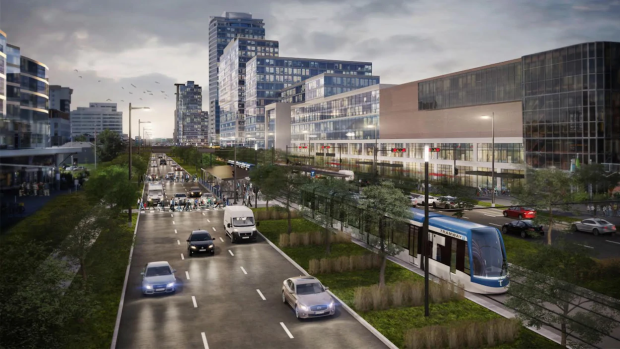Trees will fall, wetlands be filled, but Quebec City's tram will be worth it, study finds
Quebec City's proposed tramway network is expected to eliminate more than 50,000 car trips in the region each day once it's up and running in 2026 — reducing greenhouse gas emissions by 151,000 tonnes by 2041.
That's according to an environmental impact study which examines the environmental costs of the project, taking into account the four years it will take to build the network.
"During the construction phase, 2022-2026, there will be negative impacts of a temporary nature," said Daniel Genest, the engineer whose last big project was helping to oversee the construction of Montreal's new Samuel De Champlain Bridge.
Genest was hired last February to head up the provincial capital's public transit overhaul.
"They are going to be offset then by a wide range of very positive impacts during the exploitation phase. So globally, the environmental impact assessment is positive."
The electric tram network is expected to cost $3.3 billion to build, with contributions coming from the federal, provincial and municipal governments. The network will cover 23 kilometres and include two underground sections, carrying commuters from Charlesbourg to Sainte-Foy.

The environmental impact study, managed by the multinational engineering firm AECOM, was released Tuesday.
AECOM project director Laurence Goesel said the study shows the tramway will be a positive step in the fight against climate change.
The construction will still have a substantial impact on the environment: mature trees along René-Lévesque Boulevard will be cut, and nearly five hectares of wetlands — the equivalent of five soccer fields — will be destroyed in the Sainte-Foy borough for the construction of a maintenance garage.
The study estimates that about 91,000 tonnes of CO2 will be emitted during the construction phase, meaning it will take until 2032 for the emissions to balance out.
Green canopy to be improved, city says
The fact is, Genest said Tuesday, any large-scale construction project like this will affect air quality, disrupt traffic and create noise.
He should know. Genest worked for three decades as an engineer in the Canadian Armed Forces before joining SNC-Lavalin in 2011, helping to oversee the construction of the new Turcot Interchange, as well as the Samuel De Champlain Bridge.

AECOM says the impact of construction was taken into account when determining the eventual environmental benefits of the tramway.
Quebec City Coun. Normand Rémy said there will be an effort to add more vegetation and trees to the landscaping around the tracks once the network is installed.
"Our goal is to improve the canopy and the green space all along the tramway," he said.
But the main reason greenhouse gas will be reduced is because tens of thousands of commuters are expected to ditch their cars in favour of the train over a 15-year period, once the tramway is operational.
While the massive construction project is sure to cause disruptions in the short term, the project's head said the tramway will ultimately balance efficiency with thoughtful urban design.
"I think we owe it to the citizens of Quebec City to deliver two things: a performing tramway system which is comfortable and attractive, number one. But it also has to be well-integrated into the city," said Genest.


